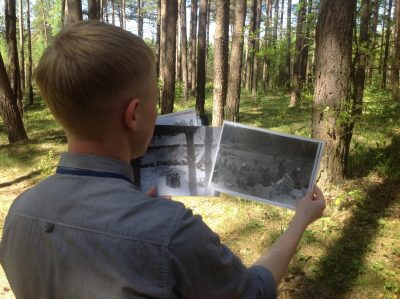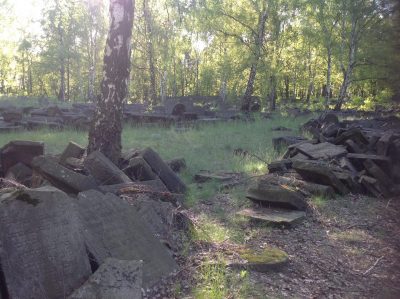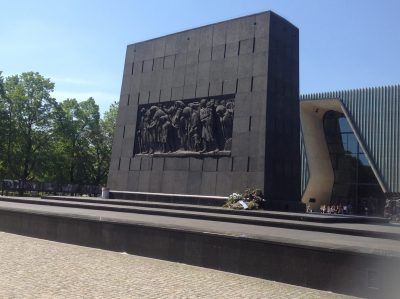Paneriai, Poland, and “Public History and the Study of Memory”
30 August 2017 – Aaron Shapiro

Exploring the historic and current landscape at Paneriai, outside Vilnius. Image credit: Aaron Shapiro
I find The Public Historian indispensable not only for keeping up with the field but also for introducing students to public history scholarship. And while I regularly assign more recent articles, I often return to David Glassberg’s “Public History and the Study of Memory” (vol. 18, no. 2, Spring 1996) in my undergraduate course, “Introduction to Public History.” Two decades after the essay first appeared, what Glassberg saw as rare is now commonplace in public history scholarship—projects draw on theories of memory, while scholars of memory incorporate public history. At the same time, public historians have increasingly heeded his call to create spaces for dialogue about competing historical and memorial narratives at historic sites and how they are created, interpreted, and understood by diverse audiences and participants.
Glassberg encourages his readers to “understand the interrelationships between different versions of history in public” (9). In previous classes, I have typically used Glassberg’s article to highlight connections between memory studies and public history, the interdisciplinary nature of the field, and the origins and development of public history theory and practice. In some classes, the reading has launched an assignment where students address questions of tragic memories and place on the landscape. While class readings address this issue, I find that on the landscape, students can see versions of the past competing for influence and explore the context in which those versions were created.

Bródno Jewish Cemetery, Warsaw. Image credit: Aaron Shapiro
Recently, I traveled to Poland and Lithuania, where I’ll be returning with students over the next three years to conduct cemetery preservation work and study the changing memorial landscape as part of a grant-funded project entitled “Preserving Memory in the Digital Age: Charlotte–Eastern Europe Cemetery Experience.” I was reminded of Glassberg’s piece, particularly its discussion of collective memory and all its forms—official, popular, vernacular, and public. At Paneriai, Lithuania, the memorial landscape from the Soviet period competed and clashed with more recent interpretations of the mass killings that took place here in the forest outside Vilnius. There, one hundred thousand individuals—including seventy thousand Jews—were killed by the Nazis. But mention of the role of Lithuanian collaborators in these events was nowhere to be found in the small museum at the site or on the memorial landscape. Our guide, an employee of the state museum that operates the site, discussed the process that will occur over the coming years to revise the interpretation to include discussion of Lithuanian collaborators.
My visit to Paneriai reminded me that many sites—as well as nations—continue to grapple with tensions between official and vernacular memory. Before traveling to Poland, I reread James Young’s The Texture of Memory, which appeared several years before Glasssberg’s essay. Young highlights the deep connections between memory, commemoration, and history in places like Warsaw and Auschwitz. By having students read Young in combination with Glassberg during the spring semester course that will precede their field experience in Poland and Lithuania, I hope that students will learn how scholars have addressed these issues and, ultimately, how they are reflected on the memorial landscape. As part of the project, students will contribute to the changing memorial landscape not only by studying it but also by working with local partners, officials, and communities to restore and interpret Jewish cemeteries. Not only will they see how memory is used to interpret the past at memorial sites, but they will become part of the process themselves.

Monument to the Ghetto Heroes, Warsaw. Image credit: Aaron Shapiro
Their work over the next three years will build on class assignments that analyze how local monuments/memorials, museum exhibits, and historic sites interpret the past to contribute to fuller interpretations of this contested landscape. At a place like Paneriai, this grounding will be essential—to better understand narratives and memories tied to Soviet propaganda, Lithuanian heroism, and more recent efforts to provide a full critical lens to this landscape of horror. Similar issues will arise when students examine Warsaw’s reconstruction by the Soviets and the changing interpretive and memorial landscape at places like the Warsaw Rising Museum, Polin Museum, the Ghetto Memorial Trail, and Nathan Rapoport’s Ghetto Heroes Monument.
Next year, we’ll emphasize questions Glassberg raised about whose version of the past becomes institutionalized and apply them to places like Poland and Lithuania. We will pay particular attention to the state’s role in establishing an official memorial landscape and, in the post–Soviet era, to how that landscape has occasionally remained static. At the same time, we will also address changes that draw on vernacular memory and that offer new official memories at sites. Students reading Glassberg will be better positioned to address questions about how societal memory is “created, institutionalized, disseminated, and understood” (7) in a local as well as global context. Ultimately, reading Glassberg will help students explore changes in public historical representation over time and allow them to compare public historical practices across cultures.
Finally, I am reminded of the wonderful passage in the opening chapter of Glassberg’s Sense of History: The Place of the Past in American Life, which I return to often with students—reminding them that the same historian is responsible for both pieces. Glassberg reminds us that a sense of history locates us in space, time, and society. It is this sense that connects official and vernacular memory, that allows us to analyze a changing landscape—memorial and otherwise—and that encourages us to ask questions about who we are individually as well as collectively and about how the world that we occupy came to be and our place in it. Over twenty years later, “Public History and the Study of Memory” still resonates in the classroom and well beyond.
~ Aaron Shapiro is associate professor and director of public history at UNC Charlotte, where he teaches courses in museum studies, digital history, historic preservation, and modern US history. In addition to directing the “Preserving Memory in a Digital Age” project, he is currently at work on a book that explores the complicated relationship between historical interpretation and place-based history in America’s public, semi-public, and private spaces.
Editor’s note: The post is the first in a series commissioned by The Public Historian that focuses on essays published in TPH that have been used effectively in the classroom. We welcome comments and further suggestions! If you have a TPH article that is a favorite in your classroom, please let us know. You can send your suggestions to [email protected].



